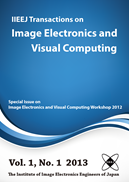Volume 9, Issue 1
Displaying 1-3 of 3 articles from this issue
- |<
- <
- 1
- >
- >|
Contributed Paper -- Special Issue on CG & Image Processing Technologies, for Automation, Labor Saving and Empowerment Part II --
-
Article type: Contributed Paper -- Special Issue on CG & Image Processing Technologies, for Automation, Labor Saving and Empowerment Part Ⅱ --
2021 Volume 9 Issue 1 Pages 2-11
Published: June 15, 2021
Released on J-STAGE: March 20, 2023
Download PDF (3778K)
Short Paper -- Special Issue on CG & Image Processing Technologies, for Automation, Labor Saving and Empowerment Part II --
-
Article type: Short Paper -- Special Issue on CG & Image Processing Technologies, for Automation, Labor Saving and Empowerment Part Ⅱ --
2021 Volume 9 Issue 1 Pages 12-19
Published: June 15, 2021
Released on J-STAGE: March 20, 2023
Download PDF (10127K)
Contributed Paper
-
Article type: Contributed Paper
2021 Volume 9 Issue 1 Pages 20-32
Published: June 15, 2021
Released on J-STAGE: March 20, 2023
Download PDF (31193K)
- |<
- <
- 1
- >
- >|
